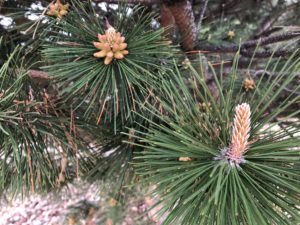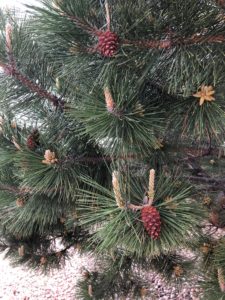This time of year in the mountains, you take a deep breath and the scent of warm pine fills your nose. Springtime in the mountains is a rejuvenating season of new growth and greening. However, mountain residents are familiar with the yellow cloud of dust, PINE POLLEN. Buildup from the pollen gets on everything including your windows!
At Peak Window Cleaning, we have 25 years of experience living with pine pollen. We get all kinds of questions about the pollen, so we are going to answer the most common, like what it is and when does it fly.

Example of male cones that produce the pollen.
What is the yellow dust? In a nutshell, the yellow dust is apart the fertilization process for Conifers. These ancient trees are Gymnosperms and rather than a typical flower, they have cones. So birds and insects are little help to pollinate. The trees depend on the wind. The trees release a large amount of the yellow dust to increase the chance of pollination.
When does the pine pollen season start? Warm temperatures are the trigger for the process. So in Evergreen, Colorado one can expect when temperatures start to reach above 70°F during the day, which is about mid-June, the pollen will start to fly. The trees will release the most pollen on warm, dry, sunny, and windy days.

Example of male and female pine cones.
When does it end? The length of time the pine pollen flies varieties each year. In the mountain communities, the pine pollen typically flies for about two to three weeks. The dust is usually done by the first few weeks of July.
What makes some years worse than others? It actually depends on the previous season. For example, a very dry year followed by a year of good rain fall, the trees will release a very large amount. In a dry year the trees lay more dormant because of the lack of moisture, as if it knows it has a less likely chance to achieve pollination.
Now that we have answered some of the most common questions about the yellow dust, we hope you will be able to plan for the pine pollen.